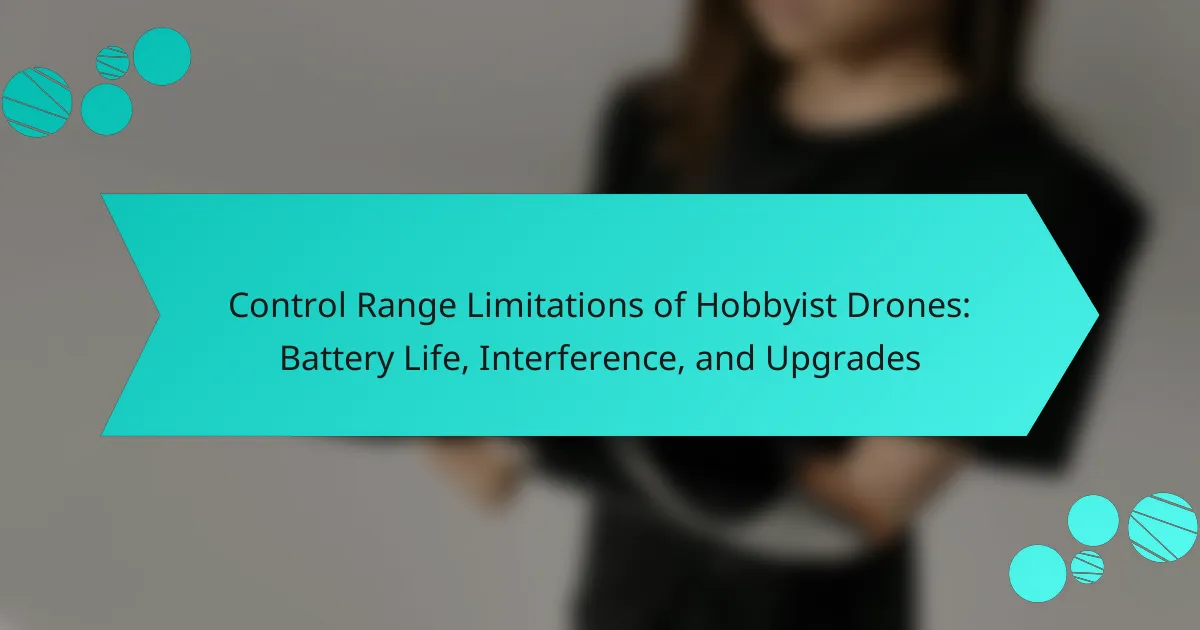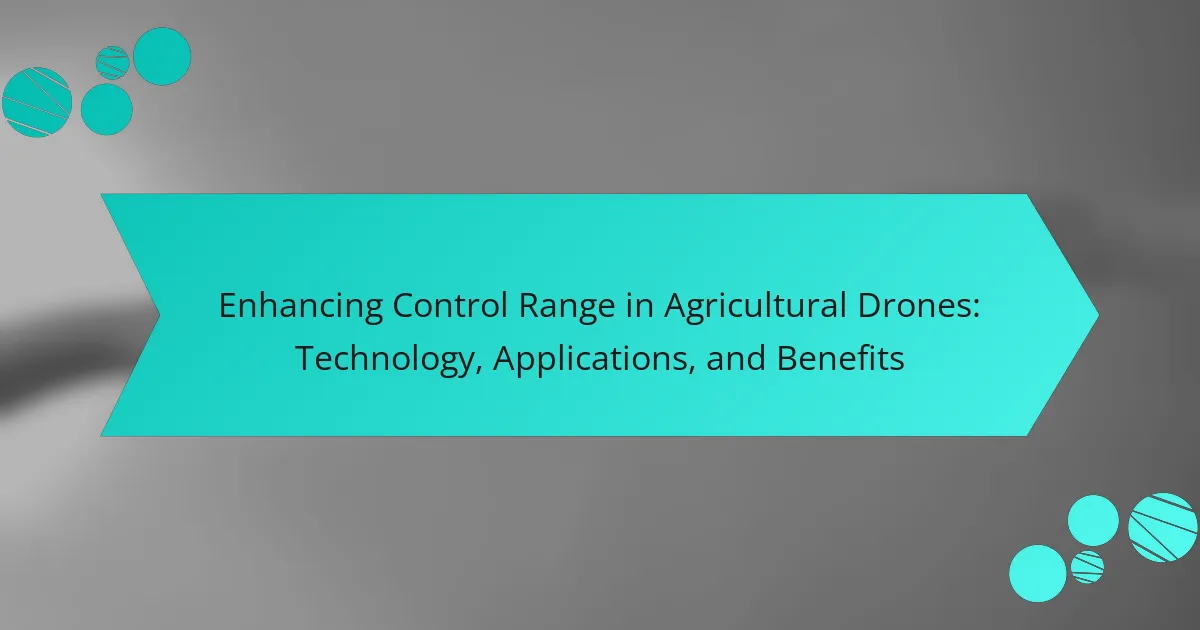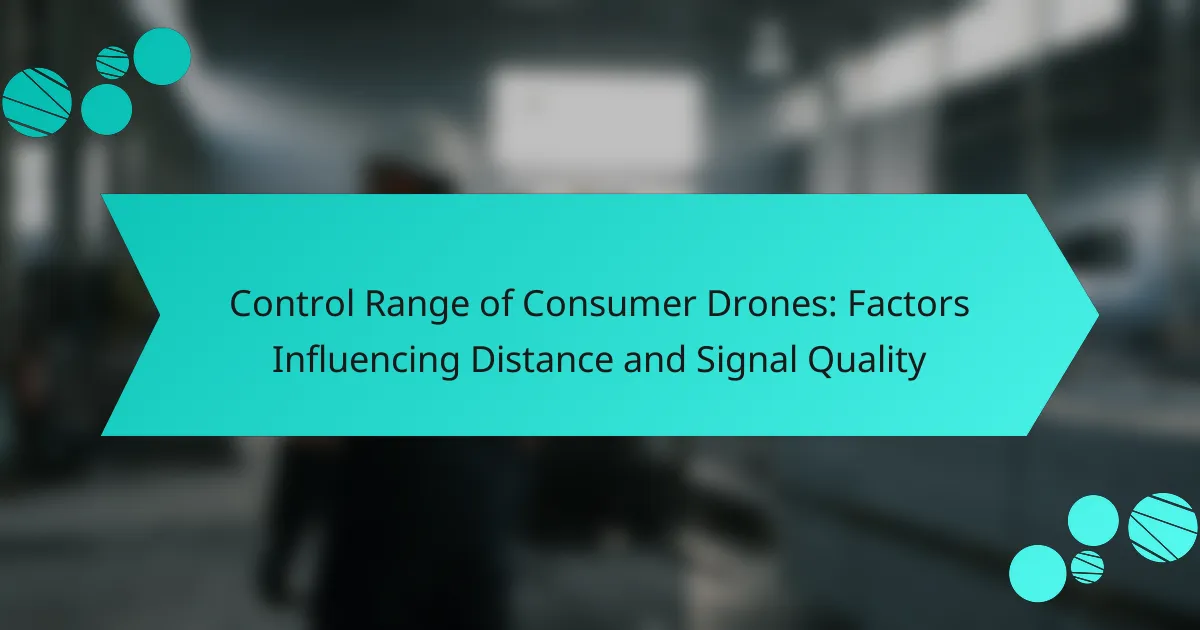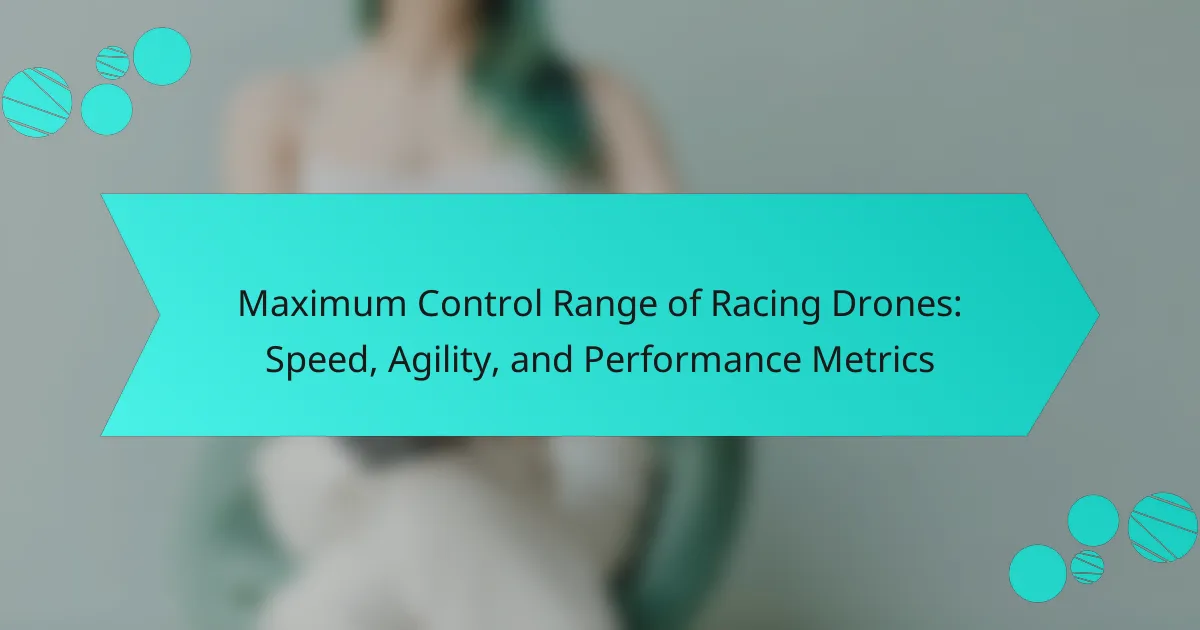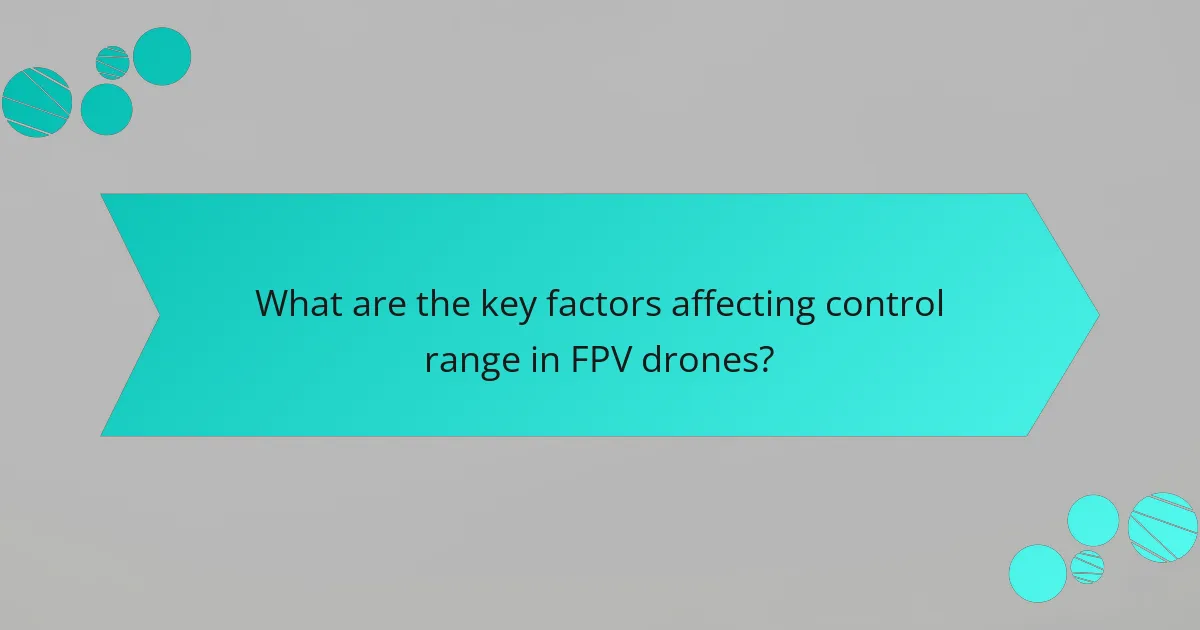
What are the key factors affecting control range in FPV drones?
The key factors affecting control range in FPV drones include antenna types, frequency bands, and environmental conditions. Antenna types influence signal strength and directionality. Higher gain antennas can extend range by focusing the signal. Frequency bands, such as 2.4 GHz and 5.8 GHz, affect [censured] and interference. The 2.4 GHz band offers longer range but is more susceptible to interference. Environmental conditions, like obstacles and terrain, significantly impact signal transmission. Dense urban areas can reduce range due to signal blockage. In contrast, open areas allow for greater control distances. These factors collectively determine the effective control range of FPV drones.
How do antenna types influence control range in FPV drones?
Antenna types significantly influence control range in FPV drones. Different antennas have varying gain levels, affecting signal strength. Higher gain antennas can transmit signals over longer distances. For example, a directional antenna focuses energy in a specific direction, extending range. Conversely, omnidirectional antennas distribute signals in all directions but may have a shorter range.
Additionally, the frequency band impacts performance. Lower frequencies typically penetrate obstacles better, enhancing range. However, higher frequencies can provide clearer signals over longer distances.
In practical terms, a study showed that drones equipped with higher gain antennas achieved control ranges up to 1.5 kilometers compared to 0.5 kilometers for standard antennas. This illustrates the direct correlation between antenna type and control range in FPV drones.
What are the different types of antennas used in FPV drones?
The different types of antennas used in FPV drones include monopole antennas, dipole antennas, patch antennas, and helical antennas. Monopole antennas are simple and provide good performance for short-range communication. Dipole antennas offer a balanced radiation pattern and are commonly used for their reliability. Patch antennas are compact and provide directional signal strength, ideal for long-range flights. Helical antennas deliver high gain and are useful for applications requiring extended range. Each antenna type has unique characteristics that affect the drone’s performance and control range.
How does antenna gain affect the control range?
Antenna gain directly influences the control range of FPV drones. Higher antenna gain focuses the signal more effectively in a specific direction. This results in a stronger and clearer signal over greater distances. For instance, a 3 dBi gain antenna will have a shorter range compared to a 9 dBi gain antenna. The increased gain allows for more power to be directed towards the intended communication path. This can mitigate interference and improve signal quality. Consequently, users can control their drones at extended distances. Studies show that a 3 dB increase in gain can double the effective range in optimal conditions. Thus, optimizing antenna gain is crucial for maximizing control range in FPV drone operations.
What role does antenna placement play in signal strength?
Antenna placement significantly influences signal strength in FPV drones. The position of the antenna affects the line of sight to the transmitter. Optimal placement minimizes obstructions that can weaken the signal. For instance, antennas placed higher generally receive stronger signals. This is due to reduced interference from buildings or terrain. Additionally, the orientation of the antenna also matters. Antennas aligned with the signal direction enhance reception. Research indicates that improper placement can lead to a 50% reduction in signal strength. Thus, strategic antenna positioning is crucial for maintaining strong communication links in FPV operations.
What frequency bands are utilized in FPV drone operations?
FPV drone operations primarily utilize the 2.4 GHz and 5.8 GHz frequency bands. The 2.4 GHz band is commonly used for control signals and telemetry. This band supports longer range but is more susceptible to interference from other devices. The 5.8 GHz band is typically used for video transmission. It offers higher data rates and less interference, though it has a shorter range. Both frequency bands are regulated for use in many countries. The choice between them often depends on the specific operational requirements of the drone.
What are the commonly used frequency bands for FPV drones?
The commonly used frequency bands for FPV drones are 2.4 GHz and 5.8 GHz. These bands are popular due to their balance of range and video quality. The 2.4 GHz band offers longer range but is more prone to interference from other devices. In contrast, the 5.8 GHz band provides higher video quality with less interference but has a shorter range. Many FPV systems utilize these frequencies for optimal performance in various environments.
How does frequency selection impact control range?
Frequency selection significantly impacts control range in FPV drones. Higher frequencies, such as 5.8 GHz, offer greater bandwidth but shorter range due to increased attenuation. Lower frequencies, like 2.4 GHz, provide extended range but may have lower data rates. Environmental factors, such as obstacles and interference, further affect performance at different frequencies. Research indicates that 2.4 GHz can achieve a control range of up to several kilometers in open areas, while 5.8 GHz may only reach a few hundred meters under similar conditions. Thus, selecting the appropriate frequency is crucial for optimizing control range in FPV applications.
What are the advantages and disadvantages of different frequency bands?
Different frequency bands have specific advantages and disadvantages in FPV drone operations. Lower frequency bands, such as 2.4 GHz, offer longer range and better [censured] through obstacles. However, they are more susceptible to interference from other devices, such as Wi-Fi. Higher frequency bands, like 5.8 GHz, provide higher bandwidth and clearer signals, which enhances video quality. Yet, they have a shorter range and reduced ability to penetrate obstacles. The choice of frequency band impacts control range significantly. For instance, 2.4 GHz can reach up to several kilometers, while 5.8 GHz typically has a range of a few hundred meters in obstructed environments. This trade-off between range and signal quality must be considered when selecting frequency bands for FPV drones.
How does the environment affect FPV drone control range?
The environment significantly affects FPV drone control range. Factors such as terrain, obstacles, and weather conditions play a crucial role. Open areas allow for longer control ranges due to fewer obstructions. In contrast, urban environments with buildings can cause signal reflections and interference, reducing range. Dense forests or mountainous regions also hinder signal transmission. Weather conditions, such as rain or fog, can absorb or scatter signals, further impacting range. Additionally, electromagnetic interference from nearby devices can disrupt communication. Overall, the environment’s characteristics directly influence the effectiveness of FPV drone control.
What environmental factors can obstruct signals?
Environmental factors that can obstruct signals include physical barriers, atmospheric conditions, and interference from other electronic devices. Physical barriers such as buildings, trees, and hills can block or reflect signals, leading to weaker communication. Atmospheric conditions like rain, fog, and snow can absorb or scatter signals, reducing their effectiveness. Additionally, interference from other electronic devices, such as Wi-Fi routers or microwaves, can disrupt signal transmission. These factors can significantly impact the control range of FPV drones. Studies indicate that obstacles can reduce signal strength by up to 30%, highlighting the importance of considering the environment in drone operation.
How does terrain influence the control range of FPV drones?
Terrain significantly influences the control range of FPV drones. Varied landscapes can obstruct or enhance signal transmission. For instance, mountainous regions create physical barriers that can reduce range. Dense forests can also absorb signals, leading to decreased control distance. In contrast, open fields allow for extended range due to fewer obstacles. The type of terrain directly impacts the line-of-sight required for optimal performance. Research indicates that control range can be diminished by up to 50% in heavily forested areas compared to open terrain. Therefore, understanding terrain is crucial for maximizing FPV drone operation.
What weather conditions can impact drone performance?
Weather conditions significantly impact drone performance. High winds can destabilize flight, making control difficult. Rain can reduce visibility and affect electronic components. Snow and ice can add weight and hinder rotor efficiency. Extreme temperatures can affect battery life and motor performance. Humidity can lead to condensation in electronics, causing malfunctions. These factors collectively determine a drone’s operational capacity and safety.
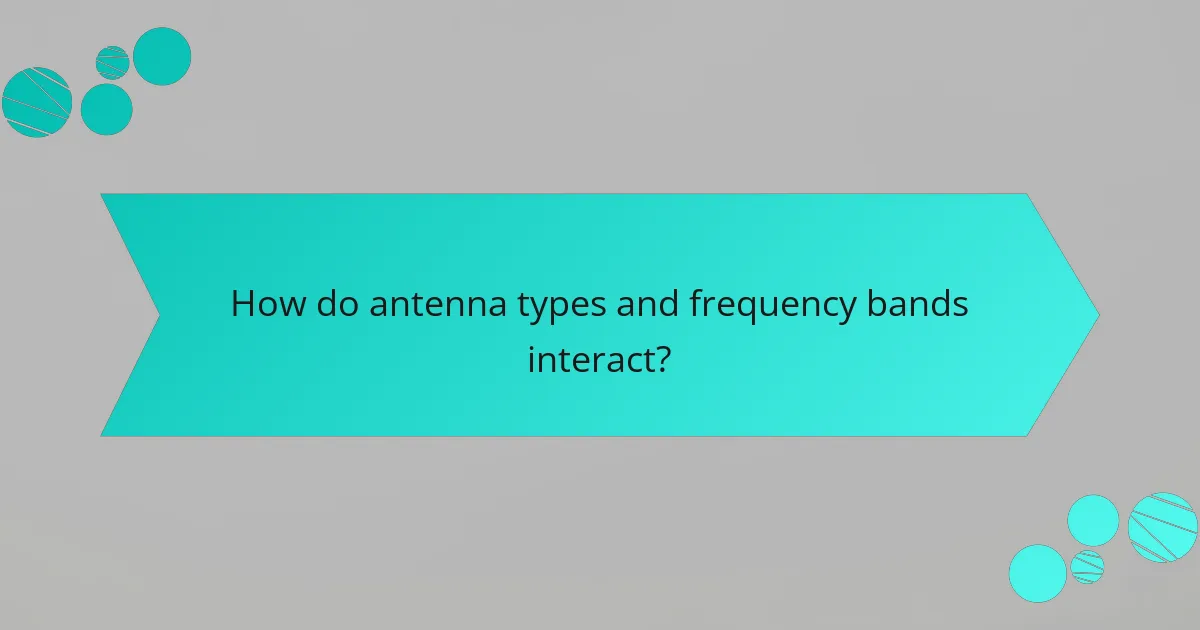
How do antenna types and frequency bands interact?
Antenna types and frequency bands interact through their design and operational characteristics. Different antenna types, such as dipole, monopole, and patch antennas, have varying radiation patterns and gain. Frequency bands determine the wavelength of the signals transmitted and received.
For example, lower frequency bands, like 2.4 GHz, require longer antennas for optimal performance. Conversely, higher frequency bands, such as 5.8 GHz, can utilize smaller antennas. The interaction affects the antenna’s ability to effectively transmit and receive signals.
Antenna gain is also frequency-dependent. Higher gain antennas can improve range and signal quality. The choice of frequency band influences the antenna’s directivity and coverage area.
In FPV drones, selecting the right antenna type for a specific frequency band is crucial for maximizing control range and minimizing interference.
What is the relationship between antenna types and frequency bands?
Antenna types are closely related to frequency bands. Different antennas are designed to operate efficiently at specific frequency ranges. For example, dipole antennas are commonly used for VHF and UHF bands. Yagi antennas provide directional gain, making them suitable for higher frequency bands.
The relationship is defined by the antenna’s design and intended use. Each antenna type has an optimal frequency range where it performs best. This is due to physical characteristics such as length and shape, which affect resonance.
For instance, a quarter-wavelength monopole antenna is effective at frequencies where its length is one-fourth of the wavelength. This correlation ensures that the antenna can transmit and receive signals effectively.
In FPV drones, selecting the right antenna type for the frequency band is crucial for maximizing control range and signal quality.
How do specific antennas perform across different frequency bands?
Specific antennas exhibit varying performance across different frequency bands due to their design and operational characteristics. For instance, Yagi antennas are effective at higher frequencies, providing directional gain and improved range. In contrast, dipole antennas perform well across a broader frequency range but may lack the same level of gain.
Monopole antennas typically offer good performance in the lower frequency bands, while patch antennas excel in specific frequency ranges with high efficiency. The gain of an antenna generally increases with frequency, enhancing signal strength and control range.
Additionally, the bandwidth of an antenna determines its ability to operate effectively over multiple frequencies. Antennas with narrow bandwidth may struggle to maintain performance across varying frequencies.
Research shows that optimal antenna selection based on frequency can significantly impact communication reliability in FPV drones. A study by Zhang et al. (2020) in the Journal of Communications highlights the importance of matching antenna types to specific frequency bands for improved control range.
What are the best combinations of antennas and frequency bands for optimal range?
The best combinations of antennas and frequency bands for optimal range in FPV drones include using directional antennas with 5.8 GHz frequency bands. Directional antennas, such as patch or Yagi antennas, focus the signal in a specific direction. This focus increases the effective range compared to omnidirectional antennas. The 5.8 GHz band is preferred for video transmission due to its higher bandwidth, allowing for clearer signals.
In contrast, 2.4 GHz frequency bands are often used for control signals. This band provides better [censured] through obstacles and longer range. Combining a directional antenna on the 5.8 GHz band with an omnidirectional antenna on the 2.4 GHz band maximizes both control and video transmission ranges.
Studies show that using high-gain antennas can extend range significantly. For instance, research indicates that a 10 dBi gain antenna can increase range by up to 10 times compared to standard antennas. Therefore, the optimal combination for maximum range involves using high-gain directional antennas on 5.8 GHz alongside omnidirectional antennas on 2.4 GHz.
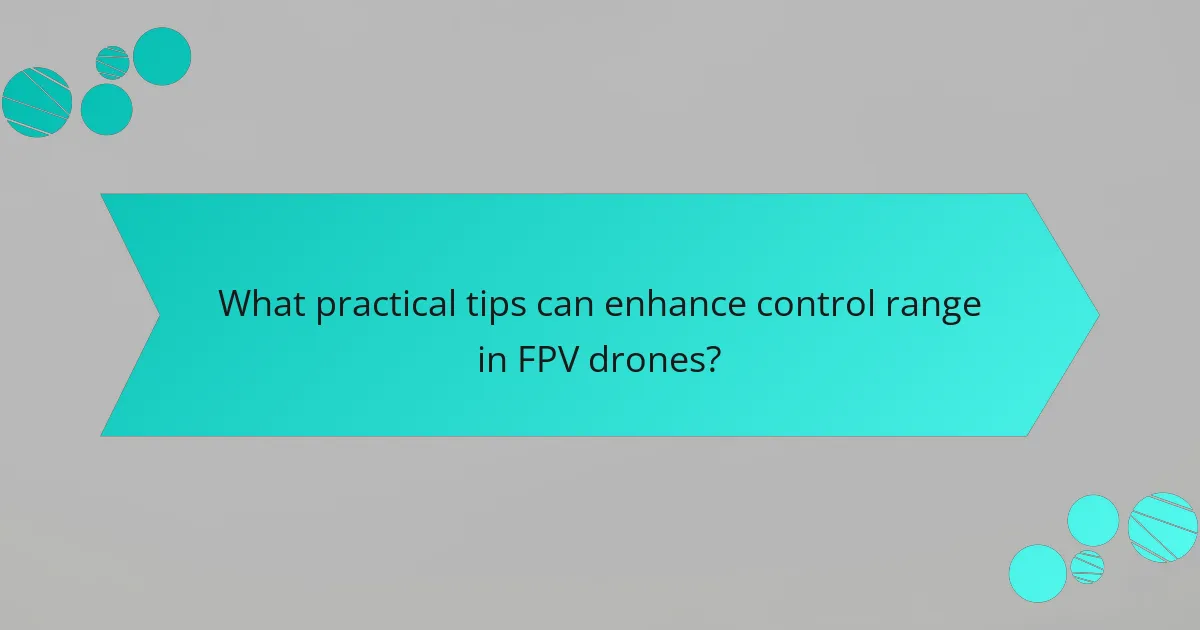
What practical tips can enhance control range in FPV drones?
To enhance control range in FPV drones, use high-gain antennas. High-gain antennas can significantly improve signal strength. Ensure a clear line of sight between the transmitter and the drone. Obstacles can block signals and reduce range. Utilize frequency bands that are less crowded. Less interference can lead to a more stable connection. Adjust the transmitter power settings if possible. Higher power can extend range but may drain the battery faster. Regularly update firmware on both the drone and transmitter. Updates can optimize performance and range. Finally, consider using signal boosters or repeaters. These devices can amplify the signal for greater distance.
How can users optimize their FPV drone setup for better control range?
Users can optimize their FPV drone setup for better control range by upgrading antennas and using higher frequency bands. High-gain antennas can significantly enhance signal strength and distance. Switching to 5.8 GHz frequency can also improve control range compared to lower frequencies. Additionally, ensuring a clear line of sight between the transmitter and drone minimizes interference. Positioning the transmitter antenna vertically can optimize signal transmission. Using a diversity receiver can also improve signal reception by switching between multiple antennas. These strategies collectively contribute to maximizing the control range of FPV drones.
What maintenance practices improve antenna performance?
Regular maintenance practices enhance antenna performance. Cleaning antennas removes dirt and debris that can obstruct signals. Inspecting connections ensures there are no loose or corroded parts. Tightening connectors prevents signal loss due to poor contact. Adjusting antenna alignment optimizes signal reception. Replacing damaged components restores functionality. Periodic testing with a signal analyzer helps identify performance issues. These practices contribute to improved signal strength and range in FPV drones.
How can users effectively choose the right frequency for their environment?
Users can effectively choose the right frequency for their environment by assessing the specific conditions of the area they operate in. Factors include terrain, obstacles, and intended range. For instance, lower frequencies like 2.4 GHz offer better [censured] through obstacles. In contrast, higher frequencies like 5.8 GHz provide better clarity over open areas. Users should also consider interference from other devices operating on similar frequencies. Conducting a site survey can help identify the most suitable frequency. This approach ensures optimal performance and minimizes signal loss.
What troubleshooting steps can be taken to address range issues?
To address range issues in FPV drones, check the antenna alignment first. Misaligned antennas can significantly reduce signal strength. Next, ensure that the drone and transmitter are using the correct frequency band. Using a crowded frequency can lead to interference. Additionally, inspect for any physical obstructions between the drone and the transmitter. Objects like trees or buildings can block signals. Also, verify that the drone’s firmware is up to date. Outdated firmware can affect performance. Lastly, consider increasing the transmitter’s power output if possible. Higher power can enhance the range. Each of these steps can help identify and resolve common range issues effectively.
The main entity of this article is FPV drones, specifically focusing on the factors that affect their control range. Key aspects discussed include the impact of antenna types, such as monopole and patch antennas, on signal strength and range, as well as the influence of frequency bands like 2.4 GHz and 5.8 GHz on performance and interference. The article also examines how environmental conditions, including terrain and weather, can obstruct signals and alter effective control distances. By understanding these factors, users can optimize their FPV drone setup for enhanced operational range and performance.
